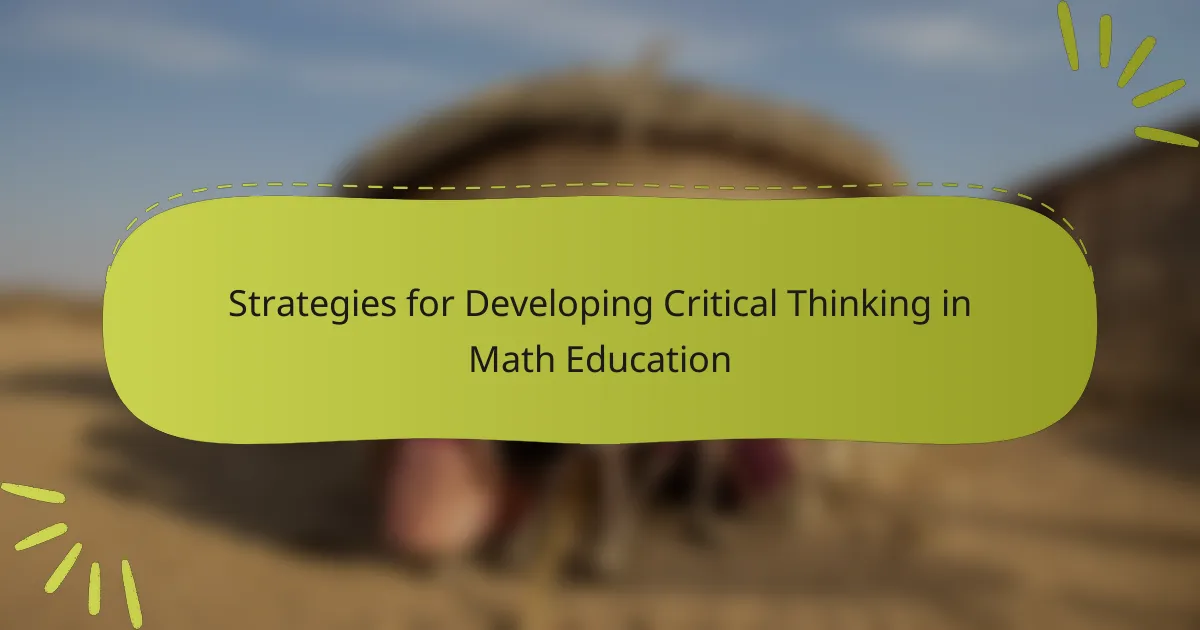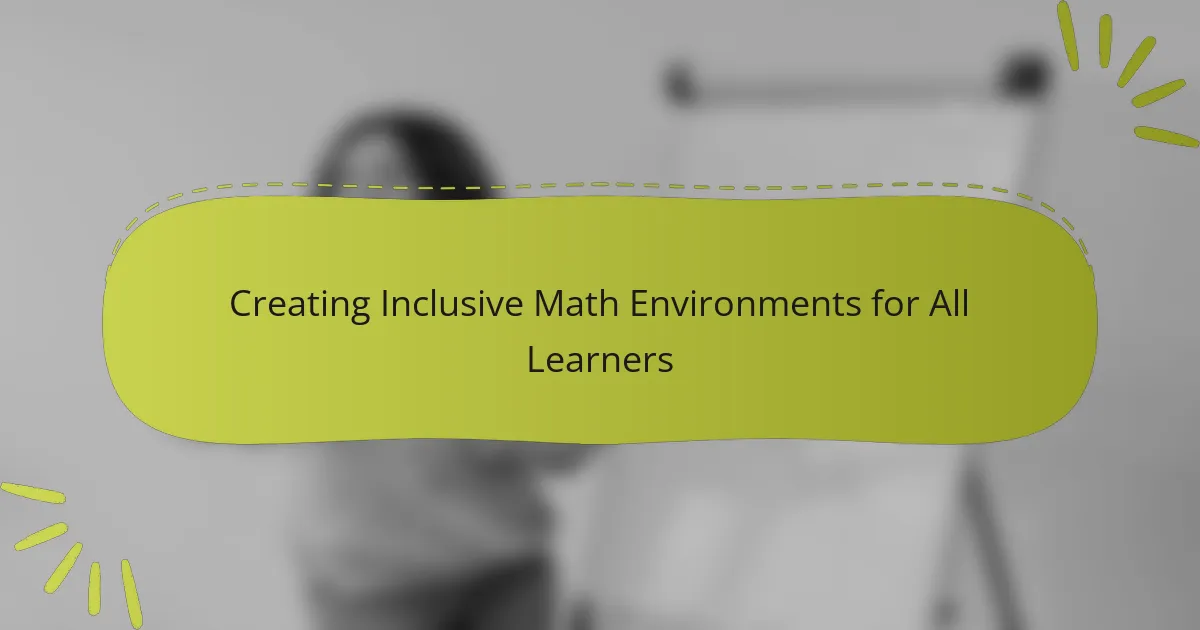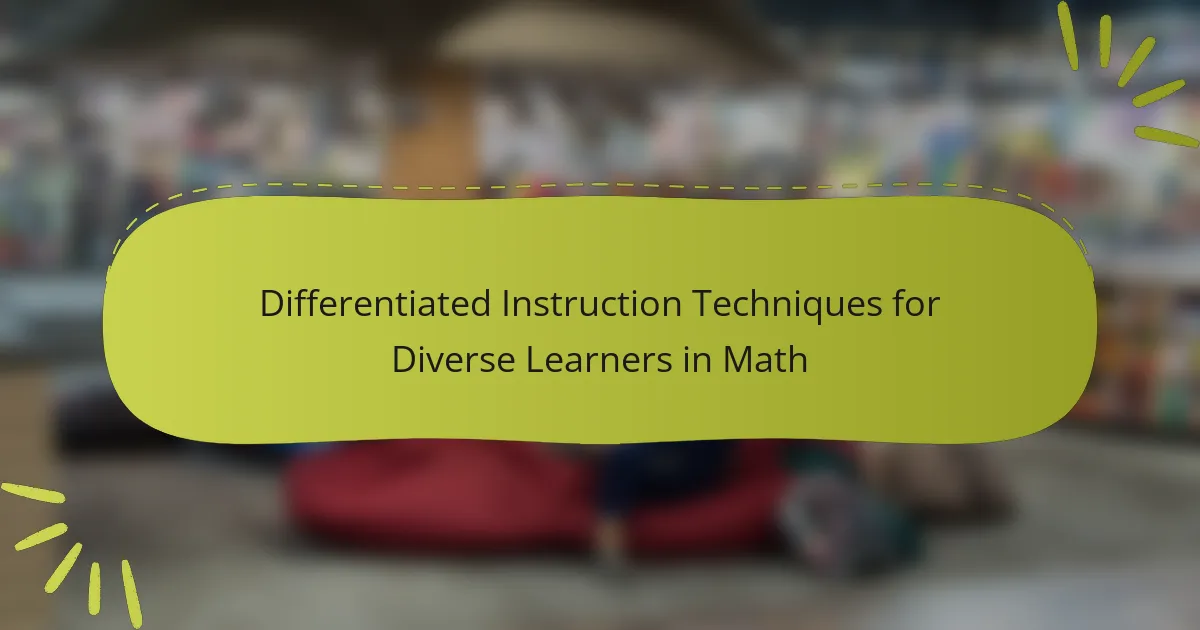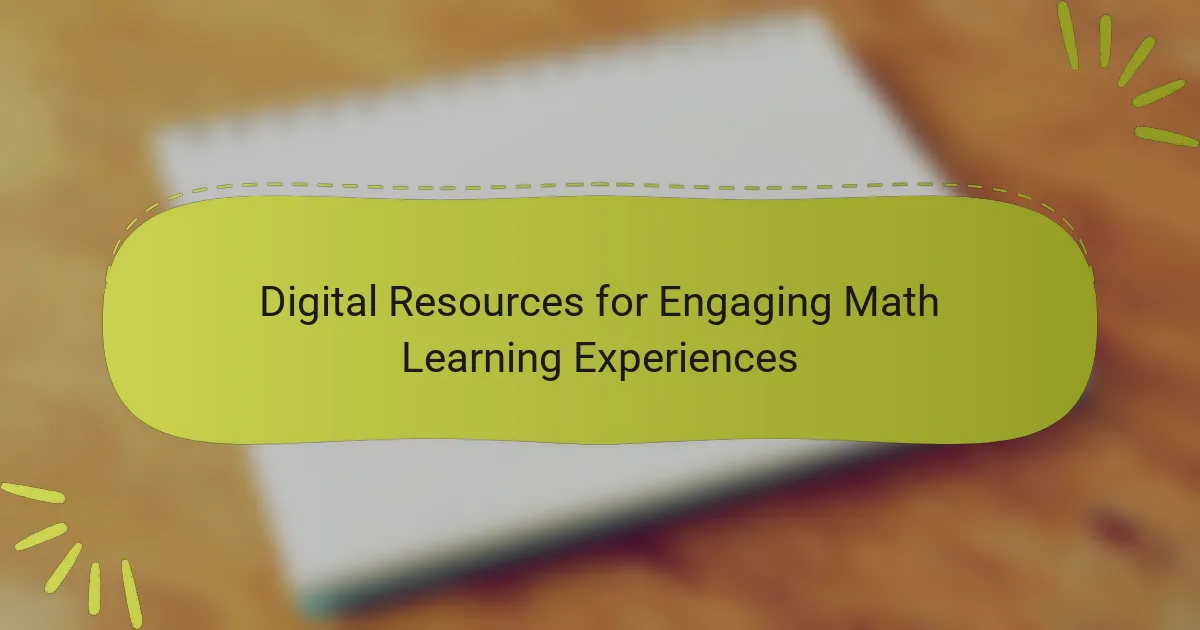Collaborative learning approaches are educational strategies designed to enhance math skills through peer interaction and shared problem-solving. These methods include group discussions, peer tutoring, and project-based learning, which facilitate deeper understanding and retention of mathematical concepts. Research, including studies by Johnson & Johnson, demonstrates that students participating in collaborative learning achieve better academic results and develop essential communication skills. Effective implementation of these approaches involves structured group roles, diverse problem-solving strategies, and the use of technology to support collaboration. Regular reflection and timely feedback further contribute to a supportive learning environment that reduces math-related anxiety and fosters skill development.
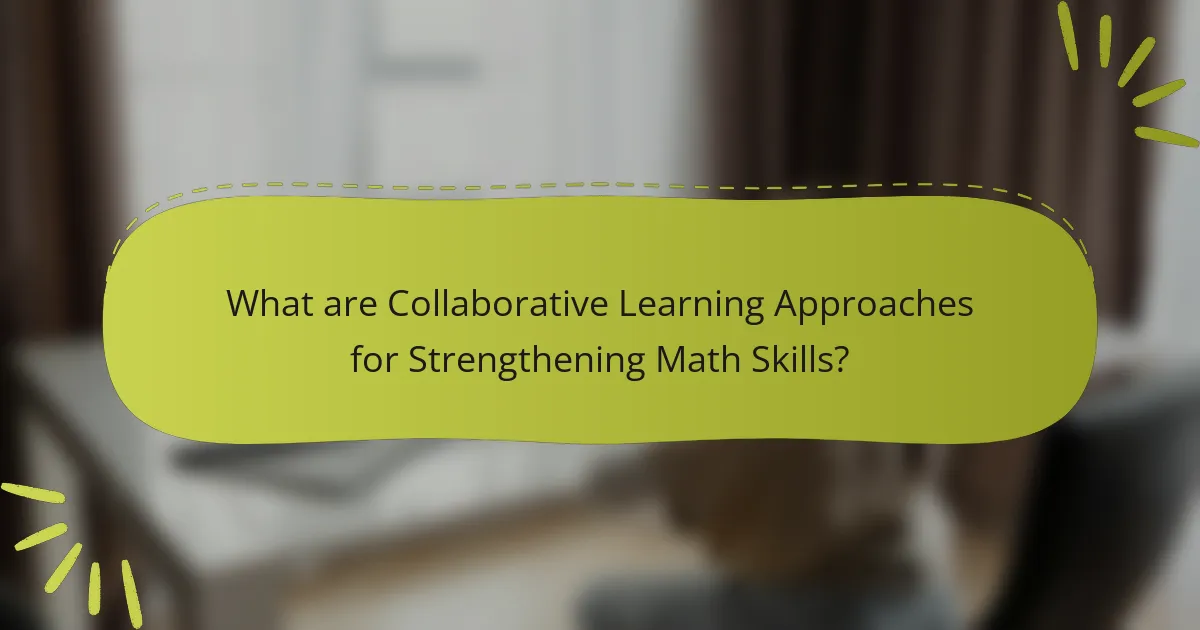
What are Collaborative Learning Approaches for Strengthening Math Skills?
Collaborative learning approaches for strengthening math skills involve students working together to solve problems and understand concepts. These methods encourage peer interaction and collective problem-solving. Techniques include group discussions, peer tutoring, and project-based learning. Research indicates that collaborative learning can enhance understanding and retention of mathematical concepts. A study by Johnson & Johnson (1999) found that students engaged in collaborative learning perform better academically than those who learn individually. This approach fosters communication skills and builds confidence in math abilities. Overall, collaborative learning creates a supportive environment that enhances math skill development.
How do collaborative learning approaches differ from traditional methods?
Collaborative learning approaches emphasize group interaction, while traditional methods focus on individual learning. In collaborative learning, students work together to solve problems and share knowledge. This fosters communication, teamwork, and critical thinking skills. Traditional methods often involve lectures and independent assignments. Research shows that collaborative learning can lead to higher retention rates and improved understanding of concepts. A study by Johnson and Johnson (1994) found that students in collaborative settings performed better academically than those in traditional environments.
What are the key principles of collaborative learning in math education?
Key principles of collaborative learning in math education include active participation, shared responsibility, and communication. Active participation involves all students engaging in problem-solving and discussions. This engagement enhances understanding and retention of mathematical concepts. Shared responsibility means students work together and support each other’s learning. Research shows that this approach fosters a sense of community and encourages peer teaching. Effective communication is essential in collaborative settings. It allows students to articulate their thought processes and reasoning. Studies indicate that students who discuss math concepts collaboratively perform better than those who work individually. These principles collectively create an environment conducive to deeper learning and skill development in mathematics.
Why are collaborative learning approaches effective for math skill development?
Collaborative learning approaches are effective for math skill development because they foster peer interaction and discussion. This interaction enhances understanding through diverse perspectives. Students can clarify concepts by explaining them to each other. Research shows that collaboration increases engagement and motivation in learning environments. A study by Johnson and Johnson (1999) found that students in collaborative settings performed better in problem-solving tasks compared to those learning individually. Furthermore, collaborative learning promotes critical thinking and communication skills. These skills are essential for mastering complex mathematical concepts. Overall, collaborative learning creates a supportive environment that enhances math proficiency.
What types of collaborative learning strategies can be used in math?
Peer teaching is a collaborative learning strategy used in math. In this approach, students explain concepts to each other. This method reinforces their understanding and builds communication skills. Group problem-solving is another effective strategy. Students work together to tackle math problems, enhancing critical thinking. Jigsaw learning is also beneficial. Each student learns a specific part of a topic and teaches it to the group. This encourages accountability and ensures comprehensive understanding. Additionally, math centers promote collaboration. Students rotate through different stations, engaging in various activities. Research shows that these strategies improve student performance and engagement in math.
How can group work enhance math understanding among students?
Group work enhances math understanding among students by promoting collaborative problem-solving. When students work together, they share diverse perspectives and strategies. This interaction can clarify concepts that may be confusing when studied alone. Research indicates that collaborative learning leads to deeper cognitive processing. A study by Johnson and Johnson (1999) found that students engaged in group work performed better on math assessments. Group discussions allow students to articulate their reasoning. This verbalization reinforces their understanding and retention of mathematical concepts. Additionally, group work fosters a supportive learning environment. Students feel more comfortable asking questions and seeking help from peers. Overall, group work effectively deepens students’ comprehension of math.
What role does peer tutoring play in collaborative math learning?
Peer tutoring enhances collaborative math learning by fostering a supportive environment. It allows students to explain concepts to each other, reinforcing their understanding. Research indicates that peer tutoring improves academic performance in mathematics. A study by Topping (2005) found that students who engage in peer tutoring show greater gains in math skills. This method promotes engagement and motivation among learners. Additionally, peer tutors develop their own skills through teaching. Overall, peer tutoring is a valuable strategy in collaborative math learning settings.
What challenges do educators face when implementing collaborative learning in math?
Educators face several challenges when implementing collaborative learning in math. One primary challenge is managing diverse skill levels among students. This diversity can lead to frustration for both advanced and struggling learners. Another challenge is ensuring effective communication among group members. Poor communication can hinder collaboration and understanding of mathematical concepts. Additionally, educators often struggle with assessing individual contributions in group settings. Traditional assessment methods may not accurately reflect each student’s understanding. Time constraints also pose a challenge, as collaborative activities can require more time than traditional instruction. Lastly, some educators may lack training in facilitating collaborative learning, impacting their effectiveness in guiding student interactions.
How can teachers overcome resistance to collaborative methods?
Teachers can overcome resistance to collaborative methods by fostering a positive classroom culture. Establishing trust among students encourages participation. Providing clear expectations for collaboration helps students understand their roles. Training students in teamwork skills can ease initial discomfort. Incorporating small group activities gradually builds confidence. Highlighting the benefits of collaboration, such as improved problem-solving skills, motivates students. Using feedback to adjust methods shows responsiveness to student needs. Research indicates that supportive environments enhance engagement in collaborative learning (Johnson & Johnson, 2014).
What are common misconceptions about collaborative learning in math?
Common misconceptions about collaborative learning in math include the belief that it only benefits high-achieving students. In reality, collaborative learning fosters engagement and understanding for all skill levels. Another misconception is that it leads to lower individual accountability. Research shows that structured group work can enhance personal responsibility. Some think collaborative learning is merely socializing. However, it is a structured approach that promotes problem-solving and critical thinking skills. Additionally, there is a belief that it hinders the development of independent work skills. In fact, it can complement individual learning by providing diverse perspectives. Lastly, some educators assume that collaborative learning is time-consuming. Studies indicate that when implemented effectively, it can lead to quicker mastery of concepts.
How can technology support collaborative learning in math education?
Technology can support collaborative learning in math education by providing interactive tools and platforms for students to engage with each other. Online collaboration tools, such as Google Classroom and Microsoft Teams, facilitate real-time communication and resource sharing. Virtual manipulatives and math software, like GeoGebra, enhance understanding through visual representation of concepts.
Research shows that students using collaborative technologies improve problem-solving skills and conceptual understanding. A study by the International Society for Technology in Education found that 85% of teachers reported increased student engagement through technology use in collaborative settings. Additionally, platforms like Khan Academy offer peer discussion forums that promote teamwork and collective learning.
These technologies not only foster collaboration but also allow for personalized learning experiences, catering to diverse learning styles. By integrating technology, educators can create a more interactive and supportive environment for math education.
What tools and platforms facilitate collaborative math learning?
Tools and platforms that facilitate collaborative math learning include Google Classroom, Microsoft Teams, and Edmodo. Google Classroom allows teachers to create assignments and foster communication among students. Microsoft Teams provides a collaborative workspace with chat and video conferencing features. Edmodo offers a social learning platform for sharing resources and discussions. Additionally, platforms like Khan Academy enable collaborative problem-solving through shared learning materials. Research shows that these tools enhance student engagement and improve learning outcomes in mathematics. For example, a study by the University of California found that collaborative tools significantly increased student performance in math assessments.
How does online collaboration impact student engagement in math?
Online collaboration significantly enhances student engagement in math. It fosters interaction among peers, which can lead to increased motivation. Collaborative platforms allow students to share ideas and problem-solving strategies. This exchange promotes a deeper understanding of mathematical concepts. A study by Johnson et al. (2014) found that students participating in online collaborative activities showed higher engagement levels. They reported feeling more connected to their classmates. Additionally, collaborative tools can provide instant feedback, which further encourages participation. Overall, online collaboration creates a supportive learning environment that positively influences student engagement in math.
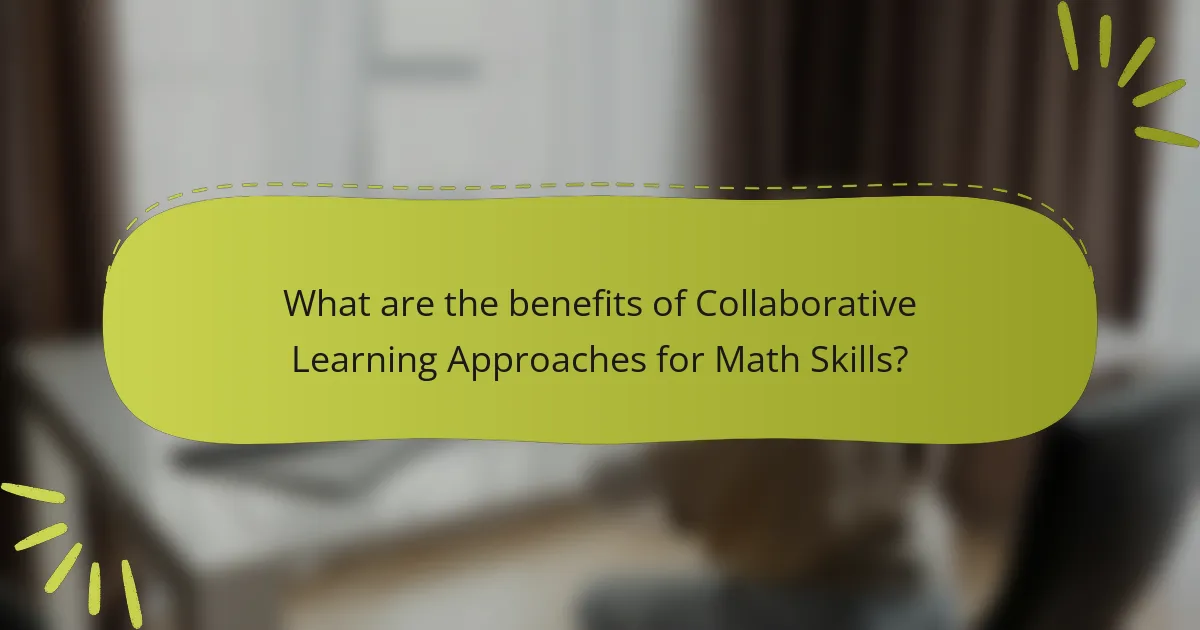
What are the benefits of Collaborative Learning Approaches for Math Skills?
Collaborative learning approaches enhance math skills through peer interaction and shared problem-solving. This method fosters deeper understanding of mathematical concepts. Students benefit from diverse perspectives, which can clarify complex topics. Collaborative learning also encourages communication skills, as students articulate their thought processes. Research shows that students engaged in collaborative learning perform better in assessments. A study by Johnson and Johnson (2009) indicates that cooperative learning leads to higher achievement and retention in mathematics. Additionally, this approach builds a supportive learning environment, reducing anxiety associated with math. Overall, collaborative learning significantly improves both comprehension and application of math skills.
How does collaborative learning improve student outcomes in math?
Collaborative learning improves student outcomes in math by enhancing understanding and retention of concepts. Students engage in discussions, which promotes deeper comprehension. This method encourages peer teaching, allowing students to explain concepts to one another. Research indicates that collaborative learning can increase academic performance by up to 50%. A study by Johnson and Johnson (1999) found that students in collaborative settings performed better than those in competitive or individual environments. Additionally, collaborative learning fosters a positive attitude towards math, leading to increased motivation. Students often report feeling more confident in their abilities when working together. Overall, collaborative learning creates a supportive environment that enhances mathematical skills.
What evidence supports the effectiveness of collaborative learning in math?
Collaborative learning in math enhances student understanding and performance. Studies show that students engaged in collaborative learning demonstrate improved problem-solving skills. Research by Johnson and Johnson indicates that collaborative learning increases retention rates by 50%. Additionally, a meta-analysis by Lou et al. found that collaborative learning approaches lead to higher achievement scores in mathematics. Furthermore, the National Mathematics Advisory Panel highlights that group work fosters deeper understanding through discussion and explanation. These findings collectively support the effectiveness of collaborative learning in math education.
How does collaboration foster critical thinking and problem-solving in math?
Collaboration fosters critical thinking and problem-solving in math by encouraging diverse perspectives. When students work together, they share different approaches to mathematical concepts. This exchange of ideas promotes deeper understanding and analysis of problems. Collaborative environments challenge students to articulate their reasoning. They must defend their solutions and consider alternative viewpoints. Research indicates that group discussions enhance cognitive skills. A study by Johnson & Johnson (2014) found that cooperative learning increases problem-solving abilities. Students engaged in collaborative tasks often develop greater mathematical reasoning. Thus, collaboration effectively strengthens critical thinking and problem-solving in math.
In what ways do collaborative learning approaches promote social skills in math?
Collaborative learning approaches promote social skills in math by encouraging teamwork and communication. Students work together to solve problems, which fosters interpersonal interactions. This interaction enhances skills such as listening, sharing ideas, and providing constructive feedback. Collaborative settings also teach conflict resolution as students navigate differing viewpoints. Research indicates that students engaged in group work demonstrate increased empathy and respect for others. Additionally, collaborative learning helps build trust among peers. These skills are essential for effective collaboration in academic and real-world scenarios. Studies show that students who participate in collaborative learning often exhibit improved social competence over time.
How does working in groups enhance communication skills in math students?
Working in groups enhances communication skills in math students by promoting active dialogue and collaboration. Group work encourages students to articulate their thought processes clearly. This interaction helps them practice explaining mathematical concepts to peers. Additionally, students learn to listen and respond to different perspectives. Engaging in discussions fosters critical thinking and problem-solving abilities. Research shows that collaborative learning improves understanding and retention of mathematical concepts. A study by Johnson and Johnson (1999) found that students in cooperative settings performed better academically. Thus, group work is a valuable tool for enhancing communication skills in math education.
What impact does collaboration have on student relationships and classroom dynamics?
Collaboration positively impacts student relationships and classroom dynamics. It fosters a sense of community among students. Collaborative learning encourages peer interaction and communication. This interaction builds trust and respect among classmates. Students learn to appreciate diverse perspectives through group work. Enhanced social skills are developed as students navigate teamwork. Research shows that collaboration improves academic performance and engagement. A study by Johnson and Johnson indicates that cooperative learning leads to higher achievement and more positive relationships.
What are the long-term advantages of using collaborative learning in math education?
Collaborative learning in math education enhances problem-solving skills over the long term. Students engage in discussions, which deepens their understanding of mathematical concepts. This approach fosters critical thinking as learners analyze different perspectives. Research shows that collaborative learning improves retention of math skills. A study by Johnson and Johnson (2009) found that students in collaborative settings scored higher on assessments. Additionally, teamwork in math promotes communication skills essential for future careers. Collaborative learning also builds a sense of community, increasing student motivation and engagement. Ultimately, these advantages lead to a more profound and lasting grasp of mathematics.
How do collaborative skills translate to future academic and career success?
Collaborative skills enhance future academic and career success by fostering teamwork and communication. Students who engage in collaborative learning develop problem-solving abilities. These skills are crucial in academic settings where group projects are common. Research indicates that 70% of jobs require teamwork and collaboration (Source: “The Future of Jobs Report 2020,” World Economic Forum). Effective collaboration leads to improved academic performance. It also prepares individuals for diverse work environments. Employers value candidates who can work well in teams. Thus, strong collaborative skills directly influence career advancement opportunities.
Why is fostering a collaborative mindset essential for lifelong learning in math?
Fostering a collaborative mindset is essential for lifelong learning in math because it enhances understanding and retention of mathematical concepts. Collaborative learning allows individuals to share diverse perspectives and problem-solving strategies. This interaction promotes deeper comprehension as learners explain concepts to one another. Research shows that students engaged in collaborative activities perform better in math assessments. A study by Johnson and Johnson (1999) highlights that cooperative learning increases achievement and retention. Additionally, collaboration builds critical thinking and communication skills. These skills are vital for applying math in real-world situations. Ultimately, a collaborative mindset supports continuous growth and adaptability in mathematical learning.
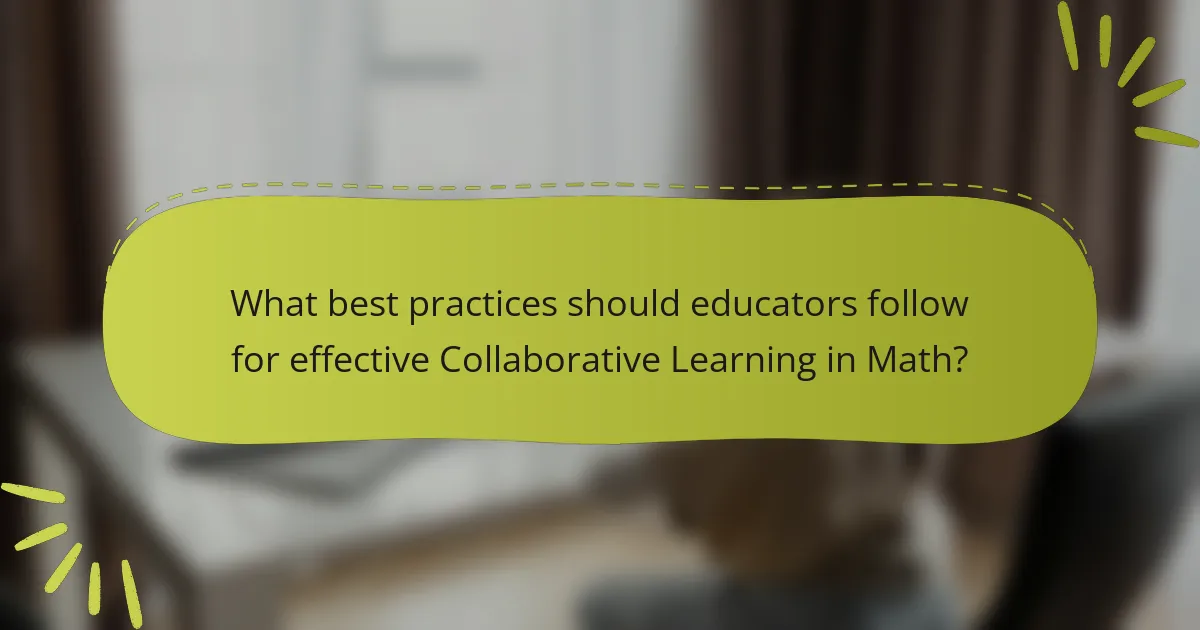
What best practices should educators follow for effective Collaborative Learning in Math?
Educators should implement structured group roles for effective Collaborative Learning in Math. Assigning specific roles, such as facilitator, recorder, or presenter, helps students engage actively. Clear expectations for each role enhance accountability and participation.
Incorporating diverse problem-solving strategies fosters creativity and critical thinking. Students should be encouraged to share different methods to reach solutions. This approach promotes deeper understanding and collaboration among peers.
Regular reflection sessions can improve the learning process. Educators should facilitate discussions on what worked well and what could be improved. This practice encourages self-assessment and accountability in collaborative settings.
Utilizing technology can enhance collaboration. Tools like online discussion boards or collaborative software support communication and resource sharing. These platforms enable continuous interaction beyond the classroom.
Finally, providing timely feedback is crucial. Educators should assess both group dynamics and individual contributions. Constructive feedback helps students understand their strengths and areas for improvement.
How can teachers create an inclusive environment for collaborative math learning?
Teachers can create an inclusive environment for collaborative math learning by establishing clear communication and setting diverse group norms. They should encourage participation from all students, ensuring every voice is heard. Teachers can provide varied resources that cater to different learning styles. Incorporating culturally relevant examples can help all students relate to math concepts. Additionally, teachers should facilitate peer mentoring, allowing stronger students to support their peers. Creating a safe space for mistakes fosters a growth mindset among students. Regular feedback can help students improve and feel valued in the learning process. Research shows that inclusive practices enhance student engagement and achievement in math.
What strategies can be employed to ensure equitable participation in math groups?
Implementing structured roles within math groups can ensure equitable participation. Assigning specific tasks to each member promotes engagement. For example, one student can be the recorder, another the presenter, and others can focus on problem-solving. This strategy encourages all members to contribute actively.
Incorporating collaborative learning techniques also fosters inclusion. Techniques like think-pair-share allow students to discuss problems in pairs before sharing with the group. This method provides a platform for quieter students to voice their thoughts.
Regularly rotating group members enhances diverse interactions. Changing group composition allows students to collaborate with different peers. This approach broadens perspectives and builds a supportive learning environment.
Setting clear expectations for participation is essential. Establishing norms around respect and listening can create a safe space for sharing ideas. This clarity helps students understand the importance of their contributions.
Utilizing formative assessments can guide participation. Teachers can identify students who may need additional support. This data can inform targeted interventions to ensure all students are engaged.
Lastly, providing positive reinforcement encourages participation. Recognizing contributions publicly can motivate students to engage more actively. Celebrating small successes fosters a culture of collaboration and support.
How should teachers assess group work in math effectively?
Teachers should assess group work in math by using clear criteria and structured rubrics. This ensures that all group members are evaluated fairly. Rubrics should include aspects like collaboration, problem-solving, and individual contributions. Teachers can observe group dynamics during tasks to gauge participation levels. Peer assessments can also provide insight into each member’s contributions. Additionally, reflective journals can help students articulate their learning experiences. Regular feedback sessions can enhance the assessment process. Research shows that structured assessments improve student accountability and engagement in group work.
What tips can educators implement to enhance collaborative learning experiences in math?
Educators can enhance collaborative learning experiences in math by implementing structured group activities. These activities should encourage students to work together on problem-solving tasks. Assign roles within groups to promote accountability and engagement. Use real-world math problems to make learning relevant and relatable. Incorporate technology, such as collaborative online tools, to facilitate communication. Provide clear guidelines and expectations for group work to ensure focus. Regularly assess group dynamics and provide feedback to improve collaboration. Research shows that structured collaboration can increase student achievement in math.
How can teachers set clear goals and expectations for collaborative tasks?
Teachers can set clear goals and expectations for collaborative tasks by defining specific, measurable objectives. They should communicate these objectives to students at the beginning of the task. Providing examples of successful collaboration can help clarify expectations. Teachers can also establish roles and responsibilities for each student within the group. This structure promotes accountability and ensures all students contribute. Regular check-ins during the task can reinforce expectations and allow for adjustments. Lastly, feedback sessions after the task can help students reflect on their collaboration and understand areas for improvement. These strategies enhance clarity and effectiveness in collaborative learning environments.
What role does feedback play in improving collaborative learning outcomes in math?
Feedback plays a critical role in improving collaborative learning outcomes in math. It enhances understanding and retention of mathematical concepts. Effective feedback provides students with specific insights into their performance. This helps them identify areas for improvement. Collaborative learning allows peers to give and receive feedback. Peer feedback fosters a supportive learning environment. Research shows that timely feedback can increase student engagement. According to Hattie and Timperley’s study, feedback can boost achievement by up to 30%. Thus, feedback is essential for maximizing collaborative learning in math.
What resources are available for educators to support collaborative learning in math?
Educators can access various resources to support collaborative learning in math. Online platforms like Khan Academy provide interactive math exercises that promote teamwork. Tools such as Google Classroom facilitate group projects and discussions. Math manipulatives, like blocks and counters, encourage hands-on collaboration. Professional development workshops offer strategies for implementing collaborative learning effectively. Resources from organizations like NCTM provide guidelines and best practices. Additionally, curriculum resources often include collaborative activities designed for group learning. These resources enhance student engagement and improve mathematical understanding through collaboration.
Where can teachers find professional development opportunities focused on collaborative learning?
Teachers can find professional development opportunities focused on collaborative learning through various educational organizations and platforms. The National Education Association (NEA) offers workshops and online courses that emphasize collaborative teaching strategies. The Association for Supervision and Curriculum Development (ASCD) provides resources and conferences dedicated to collaborative learning practices. Additionally, platforms like Edutopia and Coursera host courses that focus on collaborative learning methodologies. Many universities also offer professional development programs that include collaborative learning as a key component. Research shows that collaborative learning enhances student engagement and achievement, making these opportunities valuable for teachers.
What books or materials are recommended for enhancing collaborative math instruction?
“Collaborative Math Instruction” can be enhanced using several recommended books and materials. “Teaching Mathematics through Problem Solving” by Daniel J. Brahier focuses on collaborative strategies in math education. “The Collaborative Classroom” by Nancy L. Smith provides insights on group work in mathematics. “Mathematical Thinking and Communication” by Steven J. Brams emphasizes discussion and collaboration in math learning. Additionally, “Number Talks” by Sherry Parrish offers techniques for fostering mathematical conversations among students. Each of these resources supports the development of collaborative skills in math instruction, promoting engagement and deeper understanding.
Collaborative Learning Approaches for Strengthening Math Skills focus on methods that enhance math proficiency through peer interaction and collective problem-solving. The article outlines the differences between collaborative and traditional learning methods, highlighting key principles such as active participation and shared responsibility. It discusses various strategies like peer tutoring and group problem-solving, while also addressing challenges educators face in implementation. Additionally, the article emphasizes the importance of technology in supporting collaborative learning and the long-term benefits of developing collaborative skills for academic and career success.
